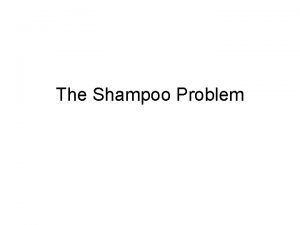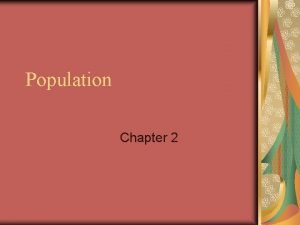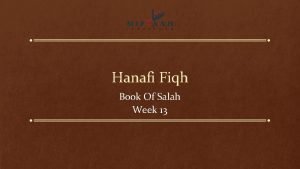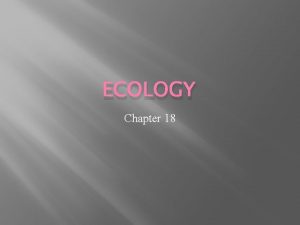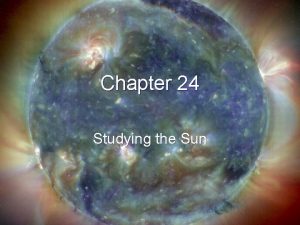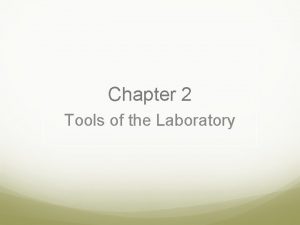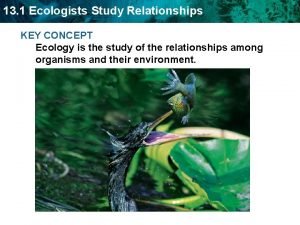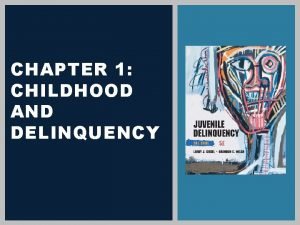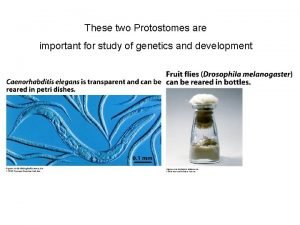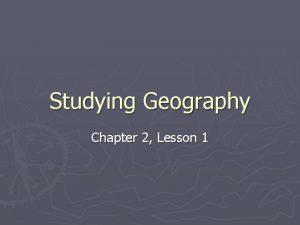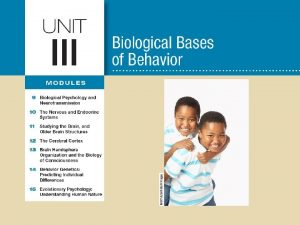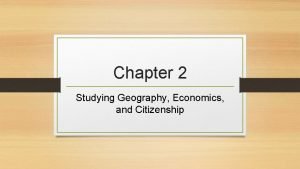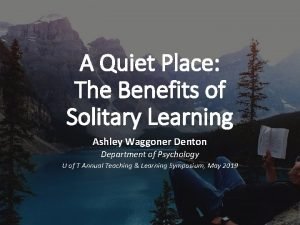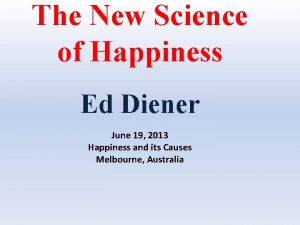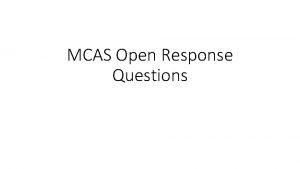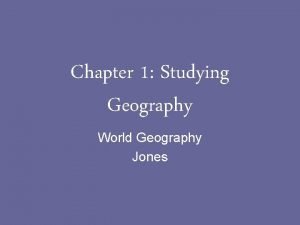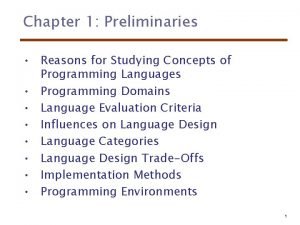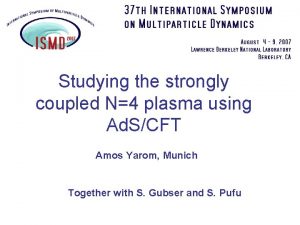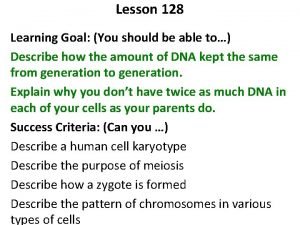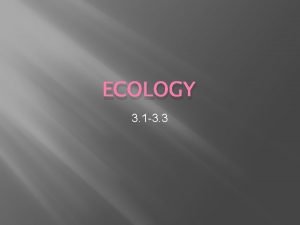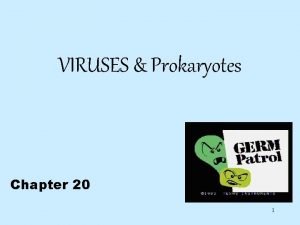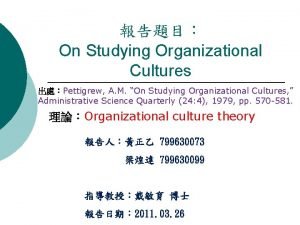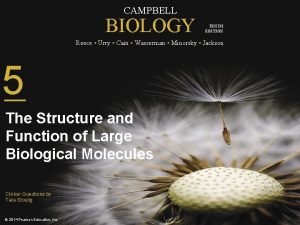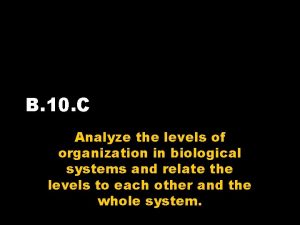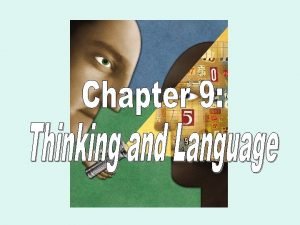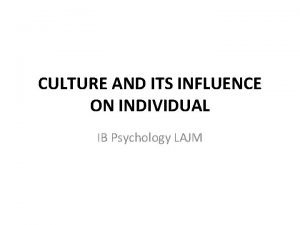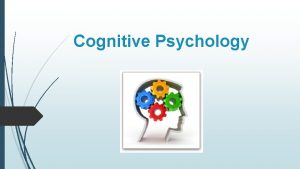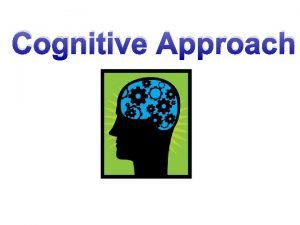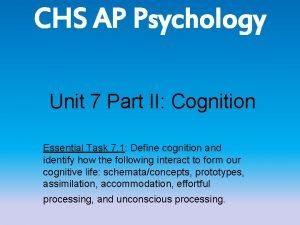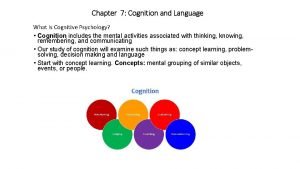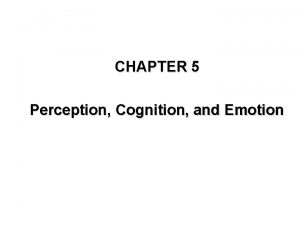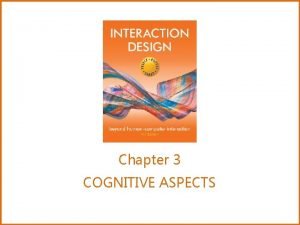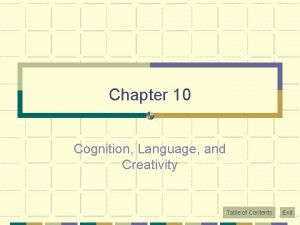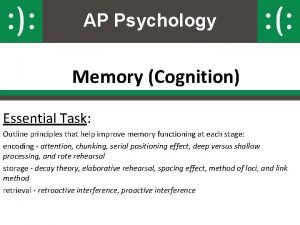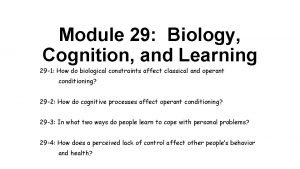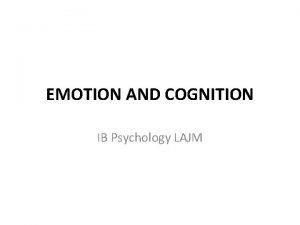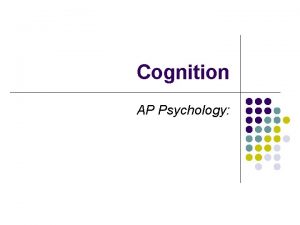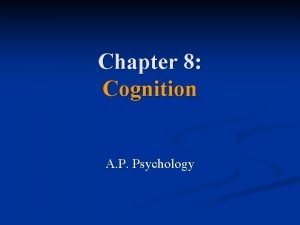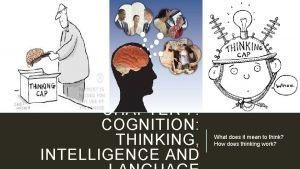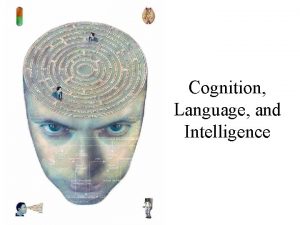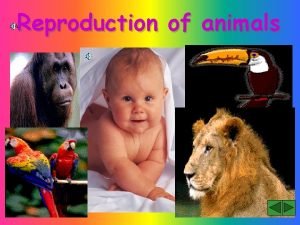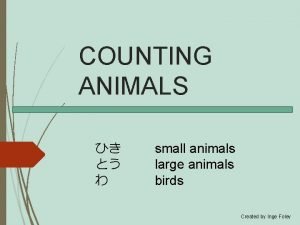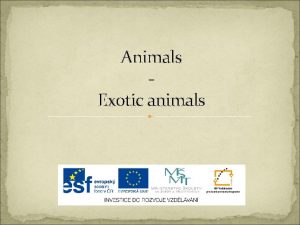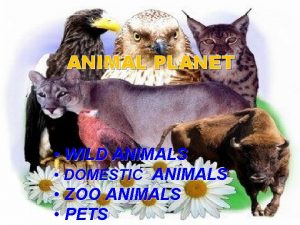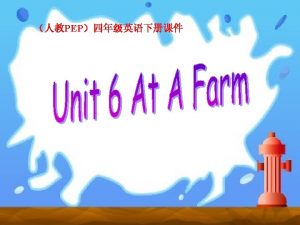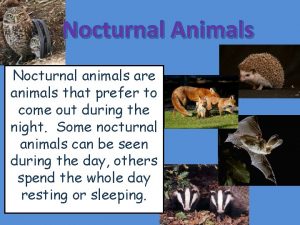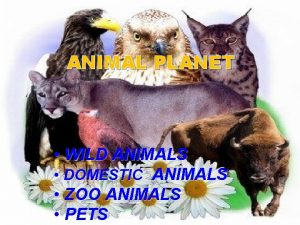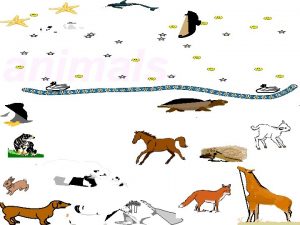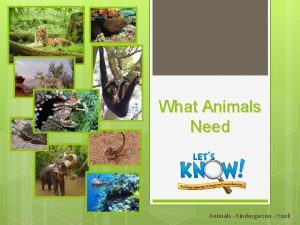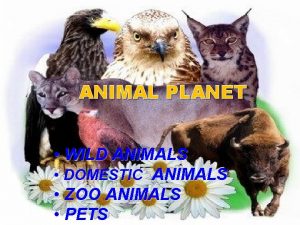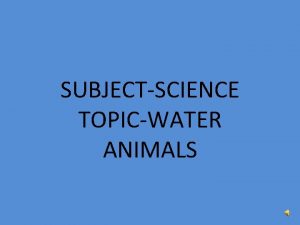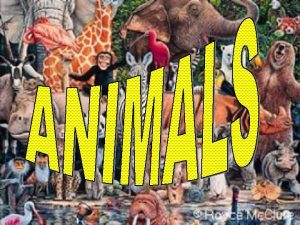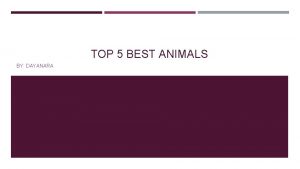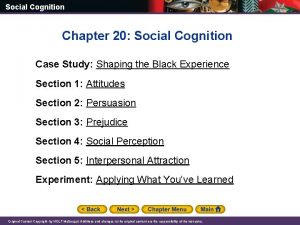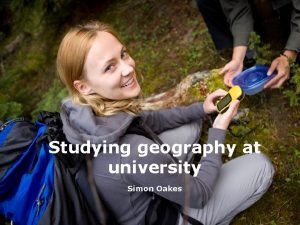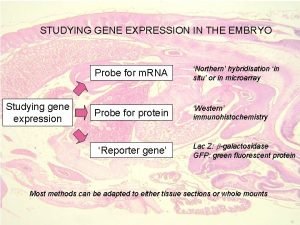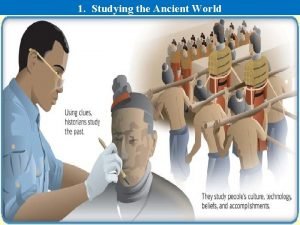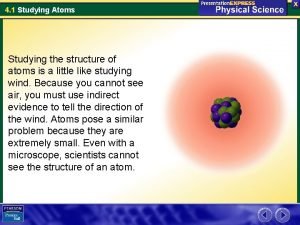Studying Cognition in Animals Cognition Cognition study of

























































- Slides: 57

Studying Cognition in Animals

Cognition § Cognition: study of the internal states and processes that produce behavior. § Consciousness: something else entirely.

Intentionality § “I’ll pick up the kids from school today”, says Max leaving for work. We’d normally say that Max’s statement conveys an intention. We can predict that he will drive from his office to the school by a certain route at a certain time and that he will change his behavior if the circumstances change. § A philosopher might say that Max exhibits intentionality.

Intentionality II § Intentionality in the philosophical sense is the property of being “about something”. § It is the defining property of mental states. § Beliefs, desires, plans, understandings, as well as intentions, are examples of intentional states. § So, a belief has to be about something.

Hierarchy of Intentionality § Zero-Order Intentionality: an animal that does not have beliefs, desires, or any intentional state, is exhibiting zero-order intentionality. § First Order: an animal with beliefs and desires about the real world or the behavior of others is a first-order intentional system. § Second Order: When an animal’s mental states concern the mental states of others.

§ Thus, if Max plans to arrive at the school on time, he is exhibiting first-order intentionality. § If he believes the children know he is coming, he is exhibiting second-order intentionality. § If he wants them to believe that he expects them to be waiting, then he is exhibiting third-order intentionality.

Practical question: § How do you measure this in an animal? l A hallmark of intention is that flexible behavior is used to achieve a goal.

Broken-wing display in plovers § E. g. , Ristau’s work § First order: plover plans to lead the fox away from the nest l Second order: plover wants the fox to think she is easy prey or has no nest

Evidence from plovers § Flexible behavior: In 87% of staged encounters with a human, plovers moved in a direction that was away from the nest. § Knowledge of other: plovers moved further away for “dangerous” intruders than “nonthreatening” intruders § Should monitor intruder: starts display when intruder can see it, if the intruder stops following, plover intensifies display, and approaches intruder. § But can more hard-wired behaviors (ethological approach) explain these changes in behavior? l Sign stimuli and vectors? Eye direction? l Series of if/then statements based on combinations of sign stimuli?

Morgan’s Canon: Accept the lowest level of intentional explanation that works § From the point of view of natural selection, what matters is that the animal achieves goals such as finding food, mates, and safety. § Using Morgan’s canon to choose among alternatives assumes that natural selection has always produced the lowest level intentional system that can do the job. § Do you all agree with this?

Why is this relevant? § Functional concerns of behavioral ecology and ethology often lead to mechanistic questions -- which are the realm of cognition. § Cognitive ethologists are frequently concerned with the diversity of solutions that living organisms have found for common problems. l They also emphasize broad taxonomic comparisons and do not focus on a few select representatives of limited taxa (we hope).

Darwin § Cognitive ethology can trace its beginnings to the writings of Charles Darwinan l and some of his contemporaries and disciples.

The Expression of Emotion in Animals and Man (Darwin, 1872) § Argument against The anatomy and physiology of expression, by Bell, l Bell claimed that humans were unique in their capacity for expressing their feelings through facial muscles. § Darwin refutes the old natural-theological position, l l through argument and expensive foldout heliotype illustrations!

Cognitive Ethology (Griffin, 1976) § The Question of Animal Awareness: Evolutionary Continuity of Mental Experience (Donald R. Griffin, 1976). § Concentrates on the evolution and evolutionary continuity of animal cognition

§ Griffin wanted to come to terms with the difficult question of "what is it like to be a particular animal? "

Griffin’s approach § § § Mental images Intentionality Language Communication Behavior is plastic, modifiable, and planning seems to be evident. § Example: Bees communicate symbolically with meaning (depends on map, who is ‘listening’, etc).

Summary of Critiques § Problem: it is suggestive but not indicative l l l one cannot make unobservable mental experience the heart of a field few theories with testable predictions ignores methods of cognitive science because they are too “restrictive”. § Speaks of mental experiences of animals (“knowing that they think”). l Concludes it must be cognition when it’s actually metacognition.

Solutions. . . § Instead ask: how is information acquired, processed, and used? l l not “does it exist? ” (mental experience). make mental events, not experiences, the heart of the field. • You don’t have to experience the events for them to be real and cognitive (the experience is metacognition). • Gives researchers something about which they can make predictions and measure.

Information-processing method Stimulus States and Processes Response § Cognition: internal states and processes that produce behavior. § This is tough: those states and processes are not directly measurable.

§ Do we need physicality of structures to account for empirical phenomena at a behavioral level? § No, not if one uses strong inference.

Problem #2 § Natural selection acts on outcomes (not mechanisms). § You can have > 1 mechanism and the same outcome or l Spatial Memory in Corvids …>1 outcome with the same mechanism. § You need to constrain the question. How? § Ecology!

Ecological Approach to Cognition Environment Transformed by. . . Cognitive Structures § Assume: function constrains mechanism. § Correspondence between Behavior mechanism and function to may not be neat. predict l How is info here… Studying ecology should give us clues.

Behavioral ecology can inform questions of cognition § Optimal Foraging Theory: maximize rate of energy intake and fitness. § Example: Woodpecker takes longer on some trees than on others when foraging. § Assume: adaptive, optimal, maximizing energy, maximizing fitness. § Function: avoid depleted food, avoid predation, stay close to nest. § Mechanism: how know depleted, what info tells bird to change behavior, how does it know where its nest is? § Measure: distances between trees, prey repletion rates, prey energy, etc.

Ex) Kinds of Memory § Reference: Information that is procedural and long term. l How to dial phone § Working: event specific and short term. l What number to dial.

Animal patrolling a territory § Reference Memory: Domain of territory and how to patrol § Working Memory: relevant events of last patrol (intruders and ripening of food). § Amakihi anecdote and study… § …avoids mist net and drives intruder into it. l spatial memory?

Learning and Foraging § Much of what goes on in foraging (MVT, OFT, etc) implies learning and memory § Operant conditioning even! § Amakihi: Always visits renewed nectaries in flowers on territory (maximizes energy intake). § Mechanism: Must remember l 1) where flowers are l 2) the last time visited § Measure: levels of nectar, time between visits, energy intake rate, spatial efficiency.

§ But do this randomly so an intruder can’t figure it out! ? ?

Food Storing Behavior § You create a resource distribution only you know. § Reference Memory: storage sites, what is in the site, territory § Working Memory: which site did I empty today? § Information: spatial layout, site contents, etc.

Spatial Memory: Corvids Ecology 1) Where is food? 2) What food is it? Cog. Struct Mechanism Offers a unique opportunity to use the comparative approach…another dimension to add. Behavior 1) Storage place 2) Food type

The Synthetic Approach to the Study of Animal Cognition § 3 Major Aspects l l l 1) Broad definition of the phenomena of interest 2) Assume and use comparative evolutionary origins 3) Emphasis on the importance of studying learning in the laboratory and in the field • Multiprocedural (to deal with L/P distinction) • Internal and External Validity

Broad Definition § Intelligence: Processes by which animals obtain and retain information about their environment and use that information to make behavioral decisions. l l l Cognitive AND adaptive Integrates nature and nurture NOT general

Comparative Evolutionary Approach § Anagenesis: linear ranking of species or a trait. l l No, no…. Please read Hodos and Campbell every year (1969) § Note: both quantitative and qualitative differences are of interest.

Laboratory and Field § If intelligence serves an adaptive function, one must look at environmental constraints. Cognitive Structures Transformed by. . . Environmental Info Behavior to predict

Laboratory/Field Studies § important for two reasons § 1) External Validity: if questions from the laboratory work in the field= RIGOR § 2) Theoretical Reasons: you’re looking at how behavior affects biological success, you must look at this in the field.

Biological Approach II § Assumes there MUST be significant variation in animal intelligence § Feather analogy: feathers are so successful birds have never lost them. But they are not so successful that there is no variation at all. l l Same goes for learning! Traits with adaptive function will therefore vary between species.

Field Studies § Learning is more difficult to observe than learned behaviors. l l Seed caching birds (contents of caches) Bees Vervets Foraging models (animals learn energy and handling time and rank items).

Research Strategies l Develop natural history of animal intelligence • foraging • social behavior • learning l Use natural history to choose species and design procedures • Field: Is there a gradient in a behavior in a set of species? • Ecological validity in lab: how does the task meet a requirement of an equivalent problem faced in nature – ex) Blue Jays and cryptic prey

Research Strategies II § learning/performance distinction versus true species differences l l Multiprocedural Approach: you cannot eliminate all variables, so change the context but keep the question the same (remember Glen Hass’s experiments from last week) Have external criteria to make predictions about species differences • This is better than a null hypothesis of NO differences • If all predictions are supported in all tests, this argues against contextual variables. • Base it on natural history

Generate multiple predictions about species differences (Strong Inference, Platt) § Divergences: differences in a cognitive trait between closely related species due to ecology. § Correlations: similarities in a cognitive trait due to similar ecology. § E. g. , Spatial memory and amakihis. Compare them to a close relative with different feeding habits or to a nectar feeding bat…. better yet….

Really do a comparative study § You need at least 3 comparisons (2 closely related, and an out-group of some sort) § Control for phylogeny AND ecology § No cat, rat, chicken, and man comparisons!

So: § Set up External Criteria § Generate Multiple Predictions § Use Multiprocedural Approach l l l Several procedures that measure the same cognitive process Test the 3 species with all the procedures Choose species based on external criterion from their natural history Make predictions in advance If the same order of species results from each different experiment, the contextual variables are unlikely to be responsible

So, part II: § 1) Broadly define learning, intelligence, and cognition § 2) Place learning, intelligence, and cognition in an evolutionary context § 3) Use behavioral ecology as a basis to study learning, etc. § 4) Use the comparative approach: l l l Your hypotheses should allow you to make multiple and detailed predictions Natural history should help you generate your multiple hypotheses Multiprocedural approach

Example: Food storing in corvids § § Gradient in Natural History Gradient in Morphology Gradient in reliance of food stores Gradient in food-storing behavior Mexican Scrub Pinyon Nutcracker

Based on Ecology: spatial § Predict: species differences in spatial memory capabilities: mexican<scrub<pinyon<nutcracker § Multiprocedural Approach l l l Radial Maze Food store and recovery (long term, short term) Operant tests of short-term spatial memory Differences in hippocampal volume Species differences hold up in all tests, no matter the context.

Sociality § It has been suggested that the cognitive demands of social living may be an important force driving the evolution of intelligence. § Kamil and colleagues have been testing this hypothesis by comparing highly-social pinyon jays (Gymnorhinus cyanocephalus) with their less social close relative, the western scrub jay (Aphelocoma callifornicus). § Tests such as observational learning (Templeton, Kamil & Balda, 1999) and transitive inference (Bond, Kamil & Balda 2002) have been used.

Based on ecology: sociality § Reference, nonspatial task l l Predictions: scrub<<pinyon Results support predictions. § Now test against nonsocial Nutcracker Scrub Pinyon

Spatial Cognition § On the small scale, Kamil and Jones were interested in how Clark's nutcrackers (Nucifraga columbiana) relocate their seed caches. § On a larger scale, they were interested in nutcrackers' ability to learn geometric relationships (Kamil & Jones, 1997, 2000) and how nutcrackers recognize locations where food has been stored (Kamil & Cheng, 2001).

Can the animal detect the information required to construct a representation (e. g. , geometric relations between objects)? § Clark’s Nutcrackers: Birds use general principle (relationship between landmarks, not between a goal and the landmarks) to find a goal located between two landmarks. 2) 1) Goal

Two Landmarks

§ Clark's nutcrackers can learn to find the point halfway between two landmarks that vary in the distance that separates them. l A general principle, as the birds correctly find the halfway point when the landmarks are presented with new distances between them. § The ability to find a point defined not by the relationship between a goal and a landmark l but by the relationship between landmarks. § Two distinct processes: l l direction: the use of directional bearings to find the (hypothetical) line connecting the landmarks and distance: finding the correct place along that line.

§ Nutcrackers were trained to find a location defined by its geometric relationship to a pair of landmarks. § Two groups were trained to find positions on the line connecting the landmarks l two groups were trained to find the third point of a triangle, -- based on either constant directional or distance relationships to the landmarks. § Four inter-landmark distances and a constant spatial orientation were used throughout training. § Result: distance group learned more slowly with less accuracy and showed less transfer to new distances -- than did birds in the other groups.

§ Finally, when tested with a single landmark l birds in the half and quarter groups tended to dig in the appropriate direction from the landmark, as did birds in the distance group. § Nutcrackers can learn a variety of geometric principles: l l directional information may be weighted more heavily than distance information the birds can use both absolute and relative, including configural, information about spatial relationships.

Three Landmarks

Hunting by search image § Five forms (or "morphs") of the North American underwing moth, Catocala relicta. (Revised from Barnes & Mc. Dunnough 1918). § Note the variable forewings and the relatively uniform hind wings. § hunting by searching image.

Stimuli § Artificial moths on artificial backgrounds.

Testing § Operant § Moth and no moth trials § Either peck moth or key saying “no moth”

Results § Runs of the same type of prey resulted in “search image” effects § Also interference effects: -- making a jay to search for one type of moth actually reduced the likelihood of its finding an alternative type. § This was the first clear demonstration of attentional interference in visual search in animals.
 Https://a-z-animals.com/
Https://a-z-animals.com/ Is a horse a producer consumer or decomposer
Is a horse a producer consumer or decomposer Detritus food chain
Detritus food chain Carnivore
Carnivore Researchers who are studying a new shampoo
Researchers who are studying a new shampoo Importance of studying population
Importance of studying population Evaluation method examples
Evaluation method examples Jummah prayer rakats
Jummah prayer rakats Studying in sweden as an eu citizen
Studying in sweden as an eu citizen Studying our living planet
Studying our living planet A student is studying the ecology of a playa lake
A student is studying the ecology of a playa lake Chapter 24 studying the sun
Chapter 24 studying the sun The five i's of studying microorganisms
The five i's of studying microorganisms Ecologists study relationships
Ecologists study relationships Objectives of studying juvenile delinquency
Objectives of studying juvenile delinquency Art talk chapter 2 review answers
Art talk chapter 2 review answers Protostomes are
Protostomes are Chapter 2 lesson 1 studying geography
Chapter 2 lesson 1 studying geography Module 11 studying the brain and older brain structures
Module 11 studying the brain and older brain structures Culture and legacy of ancient greece stations
Culture and legacy of ancient greece stations Chapter 2 lesson 1 studying geography
Chapter 2 lesson 1 studying geography Benefits of studying in a quiet place
Benefits of studying in a quiet place Imagine you are studying english
Imagine you are studying english Swb uiuc
Swb uiuc Kendra is studying the energy pyramid shown
Kendra is studying the energy pyramid shown Importance of literature
Importance of literature Lesson 1 studying geography
Lesson 1 studying geography Reasons for studying concepts of programming languages
Reasons for studying concepts of programming languages Studying
Studying Active recall and spaced repetition
Active recall and spaced repetition Studying
Studying Section 1 studying viruses and prokaryotes
Section 1 studying viruses and prokaryotes Why are chemists interested in studying thermochemistry?
Why are chemists interested in studying thermochemistry? Edgar schein 3 levels of culture
Edgar schein 3 levels of culture A polysaccharide you are studying contains unbranched
A polysaccharide you are studying contains unbranched A student is studying the ecology of a playa lake
A student is studying the ecology of a playa lake Belief perseverance
Belief perseverance Thought content examples
Thought content examples Sensorium mse
Sensorium mse Cultural dimensions ib psychology
Cultural dimensions ib psychology What is cognition
What is cognition Cognition definition
Cognition definition Cognition definition ap psychology
Cognition definition ap psychology Chapter 7 cognition thinking intelligence and language
Chapter 7 cognition thinking intelligence and language What is cognition
What is cognition Objectives of perception
Objectives of perception Altered cognition in older adults is commonly attributed to
Altered cognition in older adults is commonly attributed to What is cognition
What is cognition Cognition definition
Cognition definition Chunking ap psychology examples
Chunking ap psychology examples Ap psychology unit 7 cognition
Ap psychology unit 7 cognition Module 29 biology cognition and learning
Module 29 biology cognition and learning Jalan pintas mental
Jalan pintas mental Teacup ib psychology
Teacup ib psychology Chomsky ap psychology
Chomsky ap psychology Embodied cognition ap psychology
Embodied cognition ap psychology Embodied cognition ap psychology
Embodied cognition ap psychology Cognition thinking intelligence and language
Cognition thinking intelligence and language




